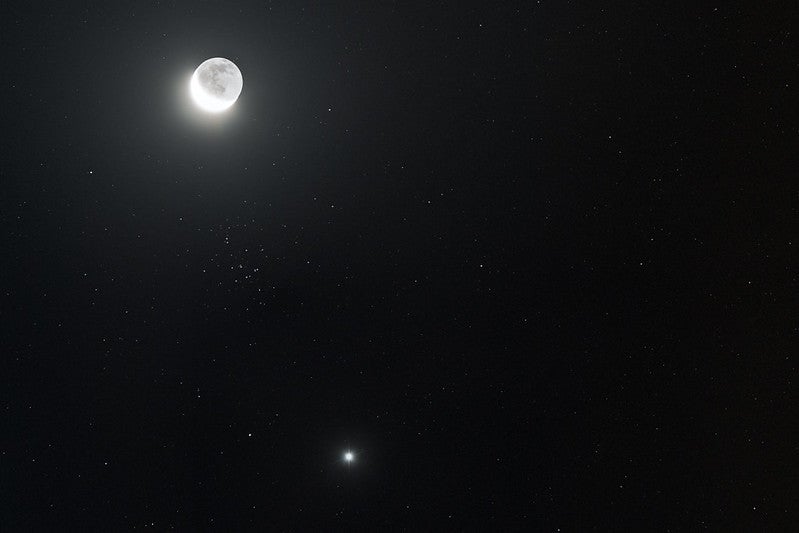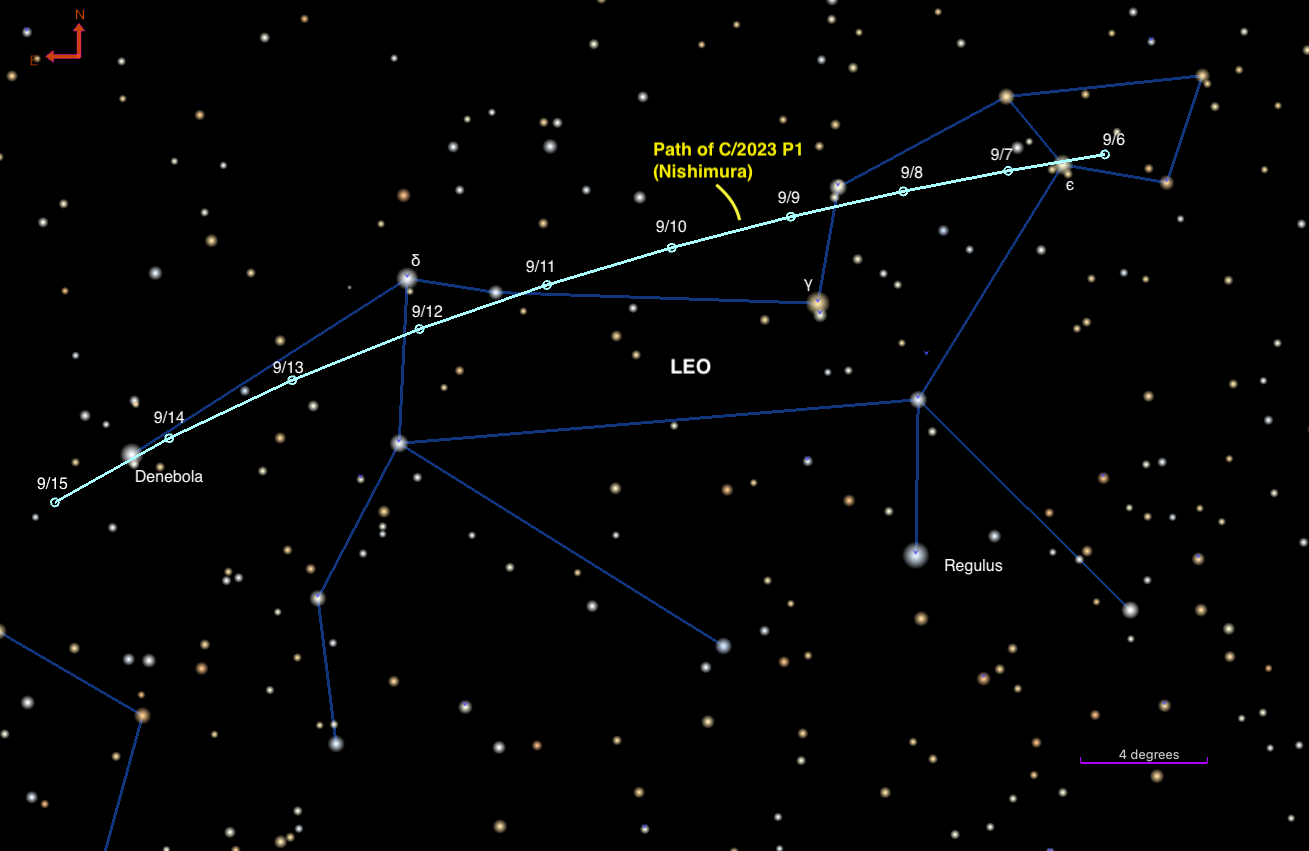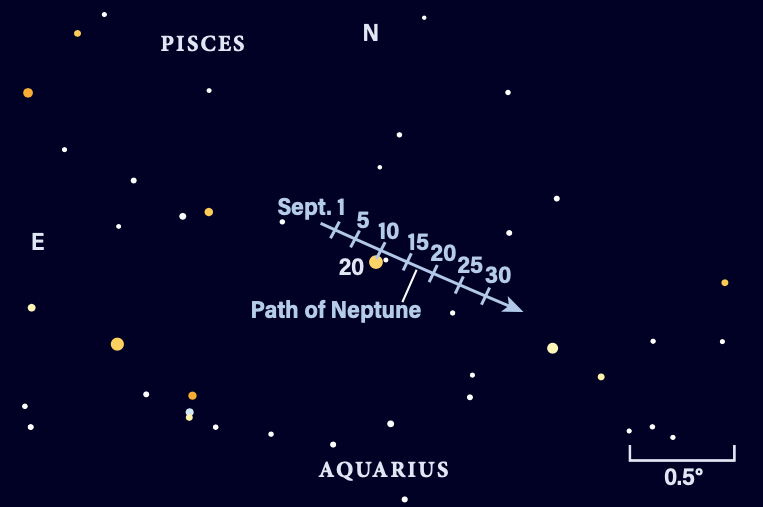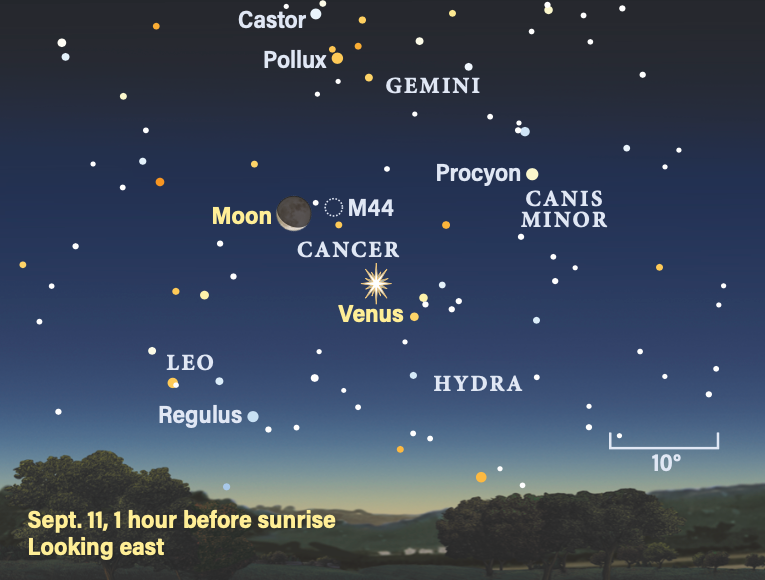
Friday, September 8
Although the heat of summer still lingers, the constellations of winter are starting to rise earlier each night. Within a few hours of sunset, the Pleiades star cluster in Taurus is visible well above the horizon. This naked-eye object has been known since antiquity, and its rising likely marked the changing of the seasons for ancient skywatchers.
Also cataloged as M45, the Pleiades is a young grouping of stars around 100 million years old. The cluster’s visibility can be a great way to test your eyesight and the conditions at your observing site — how many individual stars can you pick out by eye? Most people can easily see six, but nine or more may appear when conditions are excellent and eyesight is at its peak. In truth, there are some 500 stars in the Pleiades. It’s so large — about 110′ across — that it’s best viewed with binoculars or a low-power scope. Too much magnification won’t show many stars at all, as you’ll be zoomed in a little too much.
Many people mistake this cluster when viewed with the naked eye for the Little Dipper asterism; the latter is much larger and always in the north, anchored at the end of its handle by the North Star, Polaris. Nonetheless, the Pleiades might appear to hang in the sky in the shape of a tiny spoon.
Sunrise: 6:34 A.M.
Sunset: 7:21 P.M.
Moonrise: 12:06 A.M.
Moonset: 4:12 P.M.
Moon Phase: Waning crescent (33%)
*Times for sunrise, sunset, moonrise, and moonset are given in local time from 40° N 90° W. The Moon’s illumination is given at 12 P.M. local time from the same location.

Saturday, September 9
Now is the time to catch the bright Comet C/2023 P1 (Nishimura). Newly discovered just a few weeks ago, it is quickly approaching perihelion, the closest it will come to the Sun. On September 17 it will reach that point from inside Mercury’s orbit.
By then, the comet will be too close to the Sun for us to see in the sky. So, we need to catch it now, as it’s rising later each morning and tracking quickly eastward through Leo. But it’s also brightening rapidly — on September 6, it was recorded at magnitude 5. By today, it should be roughly magnitude 4. It’s expected to continue brightening through perihelion, perhaps reaching magnitude 3 or even 2 before it disappears from view. You can track its position day by day using the chart above.
You may know that anything brighter than magnitude 5 should be visible to the naked eye — but in this case, there’s a catch. The comet is both fuzzy and close to the horizon, standing less than 10° high in the east an hour before sunrise this morning. So, it’s really best to try searching it out with binoculars, a telescope, or a long-exposure photograph — all of which will show the green glow of the comet’s coma.
This morning, look for Nishumura just less than 2° southeast of 3rd-magnitude Zeta (ζ) Leonis. This star is part of Leo’s Sickle asterism, which also includes Regulus (Alpha [α] Leonis) and Eta (η), Gamma (γ), Mu (μ), and Epsilon (ϵ) Leonis.
Sunrise: 6:35 A.M.
Sunset: 7:19 P.M.
Moonrise: 1:01 A.M.
Moonset: 4:58 P.M.
Moon Phase: Waning crescent (24%)

Sunday, September 10
Distant Neptune is nearly at opposition, but first it’s making a close pass of the 5th-magnitude star 20 Piscium in Pisces the Fish. The planet sits on the ecliptic between Saturn in the south and Jupiter in the east. Our solar system’s other ice giant, Uranus, lies just a little east of Jupiter, giving a clear view across the outer solar system when you step outside at night (note that Neptune isn’t visible to the naked eye and Uranus is visible without aid only from a clear, dark location).
Some two to three hours after sunset, the region hosting Neptune is rising ever higher in the southeast. Look first for the Circlet of Pisces, a seven-star asterism, or unofficial pattern of stars. The brightest sun in the oval-shaped pattern is Gamma Psc at magnitude 3.7. The rest of the stars in the circlet include 7, Theta (θ), Iota (ι), 19, Lambda (λ), and Kappa (κ) Psc.
From a point roughly in the center of the Circlet, drop your gaze about 7.7° down toward the horizon, or southeast on the sky. That should land you on 20 Psc; Neptune sits just 4′ to the star’s north, making it easy to identify. The planet glows softly at magnitude 7.7 and spans just 2″. It will likely look more like a small, “flat” star that may have a bluish or grayish tint. We’re just about a week from opposition, making now the best time to capture views of the majestic ice giant.
Sunrise: 6:36 A.M.
Sunset: 7:17 P.M.
Moonrise: 2:00 A.M.
Moonset: 5:37 P.M.
Moon Phase: Waning crescent (16%)

Monday, September 11
The Moon passes 11° north of Venus at 9 A.M. EDT; a few hours earlier, you can catch Luna hanging with Venus and the Beehive Cluster (M44) in Cancer just as the first hints of dawn are contemplating an appearance. Venus has now reached magnitude –4.8 and is unmissable as a bright morning star. It lies just over 11° south of a delicate 12-percent-lit waning crescent Moon, with the Beehive Cluster buzzing between them. See how long you can study the scene in the brightening sky.
The Beehive is an open cluster of young stars that stretches nearly 100′ across. With a total magnitude of about 3.7, it’s visible to the naked eye while the sky is still dark. Depending on your eyesight, it may look more like a misty or fuzzy patch of light. If you want to study its stars under some magnification, particularly as the sky begins to lighten, binoculars or any low-power scope will do — you can even try looking through your finder scope, which can capture the entire cluster in one view, rather than zooming in on only a portion through the higher-powered eyepiece of your telescope. (Remember how we did the same to study the Pleiades earlier in the week.)
Despite its bright light, Venus too is only a crescent when viewed under magnification. It is just 21 percent lit but spans an impressive 43″ — only 2″ shy of Jupiter’s apparent girth. Venus, of course, is a much smaller, rocky planet. It appears so large in our sky because it’s much closer than the more distant gas giant, which lies beyond the main belt of asteroids outside of Mars’ orbit. Over the course of the month, Venus will slowly fade just a touch to magnitude –4.7, but its size will shrink by 11″ even as its phase increases to 36 percent.
Sunrise: 6:37 A.M.
Sunset: 7:16 P.M.
Moonrise: 3:02 A.M.
Moonset: 6:08 P.M.
Moon Phase: Waning crescent (10%)
Tuesday, September 12
The Moon reaches apogee, the farthest point from Earth in its orbit, at 11:43 A.M. EDT. Our satellite will then stand 252,457 miles (406,290 kilometers) away. The Moon is now just two days from New. You may recall that the most recent Full Moon was a Super Moon, meaning Luna’s phase reached Full around the time our satellite reached perigee, the closest point to Earth in its orbit, making the Full Moon appear slightly larger and brighter than average. The cycle will continue for one more month, as September’s Full Moon on the 29th will also be a Super Moon that occurs near perigee.
With just a sliver of the Moon still visible in the early-morning sky, now is a great time to try catching the so-called false dawn or zodiacal light. This ethereal glow, which appears before sunrise in the fall, comes from sunlight scattering off dust in the inner solar system. Where did the dust come from? It’s most likely left by comets as they circle the Sun; warming temperatures near our star cause ice to boil off a comet, liberating plenty of surface dust along the way. This dust settles onto the ecliptic plane of the solar system and we see the light it scatters as a cone-shaped glow while the sky is still dark in the hours before dawn begins to appear. Look east from a clear, dark location for a spike of light thrusting upward along the steeply inclined ecliptic, spreading through Leo, Cancer, and Gemini. The bright planet Venus, which we focused on yesterday morning, appears embedded in the glow. The zodiacal light can be quite faint, especially if there’s nearby light pollution, but often shows up nicely in long-exposure photographs.
Viewing conditions for the zodiacal light will remain favorable for at least the next week or two, so don’t worry if you can’t get out this morning or there are clouds obscuring your view.
Sunrise: 6:38 A.M.
Sunset: 7:14 P.M.
Moonrise: 4:04 A.M.
Moonset: 6:34 P.M.
Moon Phase: Waning crescent (5%)
Wednesday, September 13
Last week, Saturn lay close to a few background stars that could be easily confused for moons. Now it’s Jupiter’s turn. Look east in the hour or two before local midnight to find the gas giant rising higher in the sky along with the stars of Aries. The magnitude –2.7 planet is readily visible to the naked eye, dominating the sparse southern regions of the Ram and far outshining 2nd-magnitude Hamal, the constellation’s alpha star, to its northwest.
Look up with binoculars or a telescope, and you’ll see that tonight Jupiter sits just 10′ east of a star: That’s 6th-magnitude Sigma (σ) Arietis.
Now, look 4′ south of that star — do you see the fainter point of light? That’s Callisto, one of Jupiter’s four Galilean moons. The other three moons are clustered closer to the planet: Around 11 P.M. EDT, Io sits close to Jupiter’s eastern limb, having just reappeared after passing behind the planet. Meanwhile, Europa and Ganymede sit in a nearly vertical line, with Europa about 30″ north of Ganymede. Keep watching to see Europa pull east while Ganymede moves west, approaching Io as the latter moves east away from the planet. Early tomorrow morning just before 3:30 A.M. EDT, Io will pass 30″ due north of Ganymede as well.
Jupiter moves slowly against the background stars in the coming days, gradually slipping southwest relative to Sigma Ari. Overnight on September 17/18, the planet will pass about 5′ south of the star.
Sunrise: 6:39 A.M.
Sunset: 7:12 P.M.
Moonrise: 5:06 A.M.
Moonset: 6:57 P.M.
Moon Phase: Waning crescent (2%)
Thursday, September 14
Mercury stands stationary against the background stars of Leo at 8 P.M. EDT. The solar system’s smallest planet is visible in the morning sky, rising around 5:30 A.M. local daylight time about 8° almost directly below Regulus, the star that marks the Lion’s heart. Try catching it in the half hour before sunrise.
Mercury spans just 9″ through a telescope and, like Venus, it is roughly 20 percent lit. It now shines at magnitude 1.7, but that brightness is changing quickly as the planet brightens more each day. Within a week, Mercury will reach magnitude 0; by the end of the month, it will be magnitude –1.
Now finished with its retrograde path, Mercury will swing slightly north and then start tracking east, heading right for 4th-magnitude Sigma Leonis. It will pass within 40″ of this star in two weeks, though the appulse will occur when the pair is below the horizon or very low after rising and shortly before or after sunrise for many observers.
New Moon occurs at 9:40 P.M. EDT, leaving the sky dark and conditions great for deep-sky viewing for at least the next several days.
Sunrise: 6:40 A.M.
Sunset: 7:11 P.M.
Moonrise: 6:06 A.M.
Moonset: 7:18 P.M.
Moon Phase: New
Friday, September 15
Want to take a peek at a dying star? Look to the constellation Lyra tonight, high in the north after dark. You can’t miss the Lyre’s brightest star, Vega, shining at magnitude 0.
From Vega, look about 6.5° south-southeast and you’ll land on two more bright stars: magnitude 3.3 Gamma Lyrae and magnitude 3.5 Beta (β) Lyrae. Draw a line between these two stars and look halfway along it — there you’ll find M57, famously known as the Ring Nebula.
Stretching about 1′ across and glowing at magnitude 8.8, this fuzzy cosmic ring is a planetary nebula composed of gas blown off by an aging red giant star. That star has since evolved into a white dwarf, whose light is still energizing the gas and lighting it up. The white dwarf lies at the very center of the nebula. It takes a large scope to spot the 15th-magnitude stellar corpse, but not so for the nebula itself — you can see the Ring with binoculars, though magnifications of 100x or more are needed to start resolving the fuzzball into a doughnut shape with a darker center and brighter rim.
Although visually the nebula looks gray or perhaps even greenish, composite images taken at different wavelengths show the shell has several layers composed of varying elements such as nitrogen, oxygen, and helium. More advanced astrophotographers can capture these “colors” for themselves by imaging in several filters.
Sunrise: 6:41 A.M.
Sunset: 7:09 P.M.
Moonrise: 7:06 A.M.
Moonset: 7:38 P.M.
Moon Phase: New

Sky This Week is brought to you in part by Celestron.









